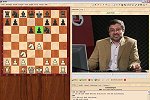


ChessBase 17 - Mega package - Edition 2024
It is the program of choice for anyone who loves the game and wants to know more about it. Start your personal success story with ChessBase and enjoy the game even more.
|
|
The Scheveningen Sicilian which usually arises after 1.e4 c5 2.Nf3 d6 3.d4 cxd4 4.Nxd4 Nf6 5.Nc3 e6 is the topic of this DVD. In 7 (!) hours, all continuations for white are covered in some detail. Being one of Kasparov´s main weapons against 1.e4, it goes without saying that the Scheveningen Sicilian offers black excellent chances to create counterplay and fight for the full point. In each chapter Ftacnik first shows the idea of the setup for white covered and explains how it can put black under pressure if black does not know how to react. He then shows a game or games where black found the correct approach. Often these games provide an overview over the history of the variation, white found a new idea, first black did not find the correct answer, but then the right answer was found. I like this way of presenting, because it makes it easy to understand why the currently judged best variations for black are good and explains clearly the drawback of other approaches.
I found Ftacnik´s coverage of the classical Scheveningen tabia which arises 6.Be2 a6 7.00 Be7 8.f4 00 9.Kh1 Qc7 10.a4 Nc6 11.Be2 Re8 specially instructive. This line became popular for black after Kasparov defeated Karpov with it in the 24th and last game of their 2nd World Championship Match (the first one was annulled) in Moscow 1995. Kasparov became World Champion for the first time after this dramatic game, but Karpov stopped playing 1.e4 for some time.
Click here for replay two highly ranked games in the Scheveningen with 12.Bd3.
Thousands of games have since then been played in this classical line, which can also arise from other Sicilians like the Taimanov, Can variation, Najdorf and Classical (5…Nc6) variations. It is not easy for club players to understand such a line because the games played are simply so many. Ftacnik explains the main ideas for both sides here very well and shows the most important games, including Anand´s victory over Kasparov in the ninth game of their PCA World Championship Match in 1995. Interestingly this was at the time, Anand´s first victory over Kasparov in a classical game since 1991. As Ftacnik explains it can be practical to vary slightly from the most well trodden path and because of this reason he also covers sensible side variations, where does not play …a6 like 6…Nc6 7.00 Be7 8.Be3 Bd7 9.Be3 e5!? .
Ftacnik´s way of presenting is quite good. He speaks a little bit slowly, but clearly and I found his explanations very good. There is both an English and also a German presentation on the DVD. I listened to some of the German version, which was slightly different from the English one as Ftacnik did not speak strictly according to a manuscript. One can thus listen to coverage of specially important lines in both languages and learn something new from each one. I found Ftacnik English grammatically more correct and a bit better than his German.

The Scheveningen Sicilian gets 4,5 out of 5 possible stars. I liked the way Ftacnik presented the material. 7 hours is also quite an impressive length. I found the DVD very instructive and like the idea to focus on tabias. As an example thousands of games have been played with the mainline against Be2 which was introduced by Kasparov and it is not easy to grasp which games and ideas are really important and which not. It is very valuable to listen to a strong player who has played the line for many years and has seen it grow and develop to what it is today and understands it very well explain what is happening and what each side should try to accomplish and avoid.

Usually there is a reason why the mainlines are mainlines, they are simply what has, over the years, been established to be the best way of playing. Hopefully Chessbase will go further in this direction and we will see many strong players which play the variation themselves cover many of the classical tabias of modern chess in future DVDs. To get 5 stars I would have liked to see more new analysis. Ftacnik presents the games and ideas a bit like someone who is neutrally watching from a distance how the variations developed. I would have liked to hear more Ftacnik´s personal opinion on the choices that black has and which lines he think will be hot in the coming years.